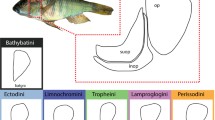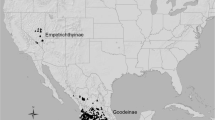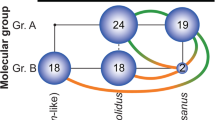Abstract
Vertebrate evolutionary radiations are the result of divergence along a variety of ecological and behavioural axes. In addition, the potential for clades to evolve along any one axis can be strongly influenced by the types and levels of phenotypic variation that are exposed to natural selection. Understanding the factors that promote and constrain morphological diversification is a central goal of evolutionary biology. Here we use the sunfishes (Centrarchidae), a perciform family containing three main clades (Lepomis, Micropterus, and a basal clade), to explore this question with respect to variation in body shape. We gathered morphological data from 26 of the 38 centrarchid species using geometric morphometrics and analyzed the resultant shape data over a time-calibrated phylogenetic tree. We find that centrarchids partitioned body shape early in their evolutionary history, a pattern that is largely associated with expansion into divergent foraging niches and elaboration of sexual ornamentation. The morphological disparity of each clade was tightly linked to integration: those clades with high disparity (Lepomis, basal clade) were the least integrated, while the opposite trend was observed in Micropterus. We also find evidence for an increase in speciation rate at the node leading to Lepomis and Micropterus, and a decline in speciation for the basal clade. Our data lead us to suggest different hypotheses for explaining accelerated speciation in Micropterus and Lepomis: invasion of a novel pursuit-predator niche that reduced resource competition (Micropterus), and the elaboration of opercular morphology (Lepomis), a trait that is linked to reproductive behaviour and facilitates mate recognition in communities with many sunfish species.




Similar content being viewed by others
References
Adams, D. C., Cardini, A., Monteiro, L. R., O’Higgins, P., & Rohlf, F. J. (2011). Morphometrics and phylogenetics: Principal components of shape from cranial modules are neither appropriate nor effective cladistic characters. Journal of Human Evolution, 60(2), 240–243. doi:10.1016/j.jhevol.2010.02.003.
Albertson, R. C., & Kocher, T. D. (2006). Genetic and developmental basis of cichlid trophic diversity. Heredity, 97(3), 211–221. doi:10.1038/sj.hdy.6800864.
Alfaro, M. E., Santini, F., Brock, C., Alamillo, H., Dornburg, A., Rabosky, D. L., et al. (2009). Nine exceptional radiations plus high turnover explain species diversity in jawed vertebrates. Proceedings of the National Academy of Sciences of the United States of America, 106(32), 13410–13414. doi:10.1073/pnas.0811087106.
Baker, W. H., Blanton, R. E., & Johnston, C. E. (2013). Diversity within the Redeye Bass, Micropterus coosae (Perciformes: Centrarchidae) species group, with descriptions of four new species. Zootaxa, 3635(4), 379–401.
Baker, W., Johnston, C., & Folkerts, G. (2008). The Alabama bass, Micropterus henshalli (Teleostei: Centrarchidae), from the Mobile River basin. Zootaxa, 67, 57–67.
Bollback, J. P. (2006). SIMMAP: Stochastic character mapping of discrete traits on phylogenies. BMC Bioinformatics, 7, 88. doi:10.1186/1471-2105-7-88.
Bolnick, D. I. (2009). Hybridization and speciation in centrarchids. In S. J. Cooke & D. P. Phillip (Eds.), Centrarchid fishes: diversity, biology and conservation (pp. 39–69). Chichester, UK: Wiley.
Bolnick, D. I., & Near, T. J. (2005). Tempo of hybrid inviability in centrarchid fishes (Teleostei: Centrarchidae). Evolution, 59(8), 1754–1767.
Burnham, K. P., & Anderson, D. R. (2002). Model selection and multimodel inference : A practical information-theoretic approach (2nd ed., p. 488). New York, NY: Springer.
Clavel, J., King, A., & Paradis, E. (2014). mvMORPH: Multivariate comparative tools for fitting evolutionary models to morphometric data (Version 1.0.2). http://cran.r-project.org/package=mvMORPH.
Collar, D. C., Near, T. J., & Wainwright, P. C. (2005). Comparative analysis of morphological diversity: Does disparity accumulate at the same rate in two lineages of centrarchid fishes? Evolution, 59(8), 1783–1794.
Collar, D. C., O’Meara, B. C., Wainwright, P. C., & Near, T. J. (2009). Piscivory limits diversification of feeding morphology in centrarchid fishes. Evolution, 63(6), 1557–1573. doi:10.1111/j.1558-5646.2009.00626.x.
Collar, D. C., & Wainwright, P. C. (2006). Discordance between morphological and mechanical diversity in the feeding mechanism of centrarchid fishes. Evolution, 60(12), 2575–2584.
Cooper, W. J., Parsons, K., McIntyre, A., Kern, B., McGee-Moore, A., & Albertson, R. C. (2010). Bentho-pelagic divergence of cichlid feeding architecture was prodigious and consistent during multiple adaptive radiations within African rift-lakes. PLoS One, 5(3), e9551. doi:10.1371/journal.pone.0009551.
Cooper, W. J., Wernle, J., Mann, K., & Albertson, R. C. (2011). Functional and genetic integration in the skulls of lake malawi cichlids. Evolutionary Biology, 38(3), 316–334. doi:10.1007/s11692-011-9124-9.
Cooper, W. J., & Westneat, M. W. (2009). Form and function of damselfish skulls: Rapid and repeated evolution into a limited number of trophic niches. BMC evolutionary biology, 9(1), 24.
Darwin, C. R. (1859). On the origin of species by means of natural selection, or the preservation of favoured races in the struggle for life (p. 502). London, UK: John Murray.
Foote, M. (1993). Contributions of individual taxa to overall morphological disparity. Paleobiology, 19(4), 403–419.
Frédérich, B., Sorenson, L., Santini, F., Slater, G. J., & Alfaro, M. E. (2013). Iterative ecological radiation and convergence during the evolutionary history of damselfishes (Pomacentridae). The American Naturalist, 181(1), 94–113. doi:10.1086/668599.
Gavrilets, S., & Losos, J. B. (2009). Adaptive radiation: Contrasting theory with data. Science, 323(5915), 732–737. doi:10.1126/science.1157966.
Goddard, K., & Mathis, A. (1997). Do opercular flaps of male longear sunfish (Lepomis megalotis) serve as sexual ornaments during female mate choice? Ethology Ecology and Evolution, 9, 223–231.
Goddard, K., & Mathis, A. (2000). Opercular flaps as sexual ornaments for male longear sunfish (Lepomis megalotis): Male condition and male–male competition. Ethology, 106, 631–643.
Goswami, A., Smaers, J. B., Soligo, C., & Polly, P. D. (2014). The macroevolutionary consequences of phenotypic integration: From development to deep time. Philosophical Transactions of the Royal Society B: Biological Sciences, 369, 20130254.
Hallgrímsson, B., Jamniczky, H., Young, N. M., Rolian, C., Parsons, T. E., Boughner, J. C., & Marcucio, R. S. (2009). Deciphering the palimpsest: Studying the relationship between morphological integration and phenotypic covariation. Evolutionary Biology,. doi:10.1007/s11692-009-9076-5.
Hansen, T. (2003). Is modularity necessary for evolvability? Remarks on the relationship between pleiotropy and evolvability. Biosystems, 69, 83–94.
Harmon, L. J., Losos, J. B., Jonathan Davies, T., Gillespie, R. G., Gittleman, J. L., Bryan Jennings, W., et al. (2010). Early bursts of body size and shape evolution are rare in comparative data. Evolution, 64(8), 2385–2396. doi:10.1111/j.1558-5646.2010.01025.x.
Harmon, L. J., Schulte, J. A., Larson, A., & Losos, J. B. (2003). Tempo and mode of evolutionary radiation in iguanian lizards. Science, 301, 961–964. doi:10.1126/science.1084786.
Hipsley, C. A., Miles, D. B., Müller, J., & Mu, J. (2014). Morphological disparity opposes latitudinal diversity gradient in lacertid lizards. Biology Letters, 10(5), 20140101.
Hodgson, J. R., He, X., Schindler, D. E., & Kitchell, J. F. (1997). Diet overlap in a piscivore community. Ecology of Freshwater Fish, 6, 144–149.
Holzman, R., Day, S. W., Mehta, R. S., & Wainwright, P. C. (2008). Integrating the determinants of suction feeding performance in centrarchid fishes. The Journal of experimental biology, 211(20), 3296–3305. doi:10.1242/jeb.020909.
Hu, Y., Parsons, K., & Albertson, R. C. (2014). Evolvability of the cichlid jaw: New tools provide insights into the genetic basis of phenotypic integration. Evolutionary Biology, 41(1), 145–153. doi:10.1007/s11692-013-9254-3.
Keenleyside, M. H. A. (1967). Behavior of male sunfishes (genus Lepomis) towards females of three species. Evolution, 21, 688–695.
Klingenberg, C. P. (2010). Evolution and development of shape: Integrating quantitative approaches. Nature Reviews Genetics, 11, 623–635. doi:10.1038/nrg2829.
Kocher, T. D. (2004). Adaptive evolution and explosive speciation: The cichlid fish model. Nature Reviews Genetics, 5(4), 288–298. doi:10.1038/nrg1316.
Lerner, H. R. L., Meyer, M., James, H. F., Hofreiter, M., & Fleischer, R. C. (2011). Multilocus resolution of phylogeny and timescale in the extant adaptive radiation of Hawaiian honeycreepers. Current biology: CB, 21(21), 1838–1844. doi:10.1016/j.cub.2011.09.039.
Losos, J. B. (1998). Contingency and determinism in replicated adaptive radiations of Island Lizards. Science, 279(5359), 2115–2118. doi:10.1126/science.279.5359.2115.
Losos, J. B. (2010). Adaptive radiation, ecological opportunity, and evolutionary determinism. American Society of Naturalists E. O. Wilson award address. The American Naturalist, 175(6), 623–639. doi:10.1086/652433.
Maan, M. E., & Seehausen, O. (2011). Ecology, sexual selection and speciation. Ecology Letters, 14(6), 591–602. doi:10.1111/j.1461-0248.2011.01606.x.
Manly, B. F. J. (1997). Randomization, bootstrap and Monte Carlo methods in biology (2nd ed., p. 480). London, UK: Chapman and Hall.
Matthews, B., Marchinko, K. B., Bolnick, D. I., & Mazumder, A. (2010). Specialization of trophic position and habitat use by sticklebacks in an adaptive radiation. Ecology, 91(4), 1025–1034.
Muschick, M., Indermaur, A., & Salzburger, W. (2012). Convergent evolution within an adaptive radiation of cichlid fishes. Current Biology, 22(24), 2362–2368. doi:10.1016/j.cub.2012.10.048.
Muschick, M., Nosil, P., Roesti, M., Dittmann, M. T., Harmon, L., & Salzburger, W. (2014). Testing the stages model in the adaptive radiation of cichlid fishes in East African Lake Tanganyika. Proceedings of the Royal Society B: Biological Sciences, 281, 1795. doi:10.1098/rspb.2014.0605.
Near, T. J., Bolnick, D. I., & Wainwright, P. C. (2005). Fossil calibrations and molecular divergence time estimates in centrarchid fishes (Teleostei: Centrarchidae). Evolution, 59(8), 1768–1782.
Near, T., Kassler, T., & Koppelman, J. (2003). Speciation in North American Black Basses, Micropterus (Actinopterygii: Centrarchidae). Evolution, 57(7), 1610–1621.
Neff, B. D. (2004). Stabilizing selection on genomic divergence in a wild fish population. Proceedings of the National Academy of Sciences of the United States of America, 101(8), 2381–2385.
Norton, S. F., & Brainerd, E. L. (1993). Convergence in the feeding mechanics of ecomorphologically similar species in the Centrarchidae and Cichlidae. Journal of Experimental Biology, 176, 11–29.
Nylin, S., & Wahlberg, N. (2008). Does plasticity drive speciation? Host-plant shifts and diversification in nymphaline butterflies (Lepidoptera: Nymphalidae) during the tertiary. Biological Journal of the Linnean Society, 94(1), 115–130. doi:10.1111/j.1095-8312.2008.00964.x.
Parsons, K. J., Márquez, E., & Albertson, R. C. (2012). Constraint and opportunity: The genetic basis and evolution of modularity in the cichlid mandible. The American Naturalist, 179(1), 64–78. doi:10.1086/663200.
Parsons, K. J., & Robinson, B. W. (2006). Replicated evolution of integrated plastic responses during early adaptive divergence. Evolution, 60(4), 801–813.
Pigliucci, M. (2008). Is evolvability evolvable? Nature Reviews Genetics, 9, 75–82. doi:10.1038/nrg2278.
Polly, P. D., Lawing, A. M., Fabre, A.-C., & Goswami, A. (2013). Phylogenetic principal components analysis and geometric morphometrics. Hystrix, the Italian Journal of Mammalogy, 24(1), 33–41. doi:10.4404/hystrix-24.1-6383.
Rabosky, D. (2006). LASER: A maximum likelihood toolkit for detecting temporal shifts in diversification rates from molecular phylogenies. Evolutionary Bioinformatics Online, 2, 247–250.
Rabosky, D. L., & Lovette, I. J. (2008). Density-dependent diversification in North American wood warblers. Proceedings of the Royal Society B: Biological Sciences, 275(1649), 2363–2371. doi:10.1098/rspb.2008.0630.
Rabosky, D. L., Santini, F., Eastman, J., Smith, S. A., Sidlauskas, B., Chang, J., & Alfaro, M. E. (2013). Rates of speciation and morphological evolution are correlated across the largest vertebrate radiation. Nature Communications, 4, 1958. doi:10.1038/ncomms2958.
Revell, L. J. (2012). Phytools: An R package for phylogenetic comparative biology (and other things). Methods in Ecology and Evolution, 3(2), 217–223. doi:10.1111/j.2041-210X.2011.00169.x.
Rohlf, F. J. (1998). On applications of geometric morphometrics to studies of ontogeny and phylogeny. Systematic Biology, 47, 147–167. doi:10.1080/106351598261094.
Rohlf, F. J. (2004). TPS Software. http://www.life.bio.sunysb.edu/morph/
Sidlauskas, B. (2008). Continuous and arrested morphological diversification in sister clades of characiform fishes: a phylomorphospace approach. Evolution, 62, 3135–3156. doi:10.1111/j.1558-5646.2008.00519.x.
Simpson, G. G. (1944). Tempo and mode in evolution (p. 237). New York, NY: Columbia University Press.
Slater, G. J., Price, S. A., Santini, F., & Alfaro, M. E. (2010). Diversity versus disparity and the radiation of modern cetaceans. Proceedings of the Royal Society B: Biological Sciences, 277(1697), 3097–3104. doi:10.1098/rspb.2010.0408.
Smith, A. J., Rosario, M. V., Eiting, T. P., & Dumont, E. R. (2014). Joined At the Hip: Linked Characters and the Problem of Missing Data in Studies of Disparity. Evolution, 68(8), 2386–2400. doi:10.1111/evo.12435.
Streelman, J. T., Alfaro, M., Westneat, M. W., Bellwood, D. R., & Karl, Sa. (2002). Evolutionary history of the parrotfishes: biogeography, ecomorphology, and comparative diversity. Evolution, 56(5), 961–971.
Streelman, J. T., & Danley, P. D. (2003). The stages of vertebrate evolutionary radiation. Trends in Ecology & Evolution, 18(3), 126–131. doi:10.1016/S0169-5347(02)00036-8.
Tobias, J. A., Montgomerie, R., & Lyon, B. E. (2012). The evolution of female ornaments and weaponry: social selection, sexual selection and ecological competition. Philosophical Transactions of the Royal Society of London. Series B, Biological sciences, 367(1600), 2274–2293. doi:10.1098/rstb.2011.0280.
Wagner, C. E., Harmon, L. J., & Seehausen, O. (2012). Ecological opportunity and sexual selection together predict adaptive radiation. Nature, 487(7407), 366–369. doi:10.1038/nature11144.
Warren, M. L, Jr. (2009). Centrarchid identification and natural history. In S. J. Cooke & D. P. Phillip (Eds.), Centrarchid fishes: Diversity, biology and conservation (pp. 375–535). Chichester, UK: Wiley.
Zachos, J. C., Dickens, G. R., & Zeebe, R. E. (2008). An early Cenozoic perspective on greenhouse warming and carbon-cycle dynamics. Nature, 451, 279–283. doi:10.1038/nature06588.
Zelditch, M. L., Swiderski, D. L., & Sheets, H. D. (2012). Geometric morphometrics for biologists: A primer (2nd ed., p. 488). Waltham, MA: Academic Press.
Acknowledgments
The authors wish to thank the Katherine Doyle (UMass, Amherst) and Caleb McMahan (Chicago Field Museum) for access to specimens. Thanks to Israel Del Toro and Benjamin Allen Concannon Smith for providing live centrarchid images. We also wish to acknowledge Elizabeth Dumont and an anonymous reviewer for comments and discussion on early versions of the manuscript. This work was funded by an OEB research grant awarded to A.J.S, the Department of Biology at UMass, Amherst, start-up funding from WSU to W.J.C, and from Glasgow University to K.J.P.
Author information
Authors and Affiliations
Corresponding author
Electronic supplementary material
Below is the link to the electronic supplementary material.
Rights and permissions
About this article
Cite this article
Smith, A.J., Nelson-Maney, N., Parsons, K.J. et al. Body Shape Evolution in Sunfishes: Divergent Paths to Accelerated Rates of Speciation in the Centrarchidae. Evol Biol 42, 283–295 (2015). https://doi.org/10.1007/s11692-015-9322-y
Received:
Accepted:
Published:
Issue Date:
DOI: https://doi.org/10.1007/s11692-015-9322-y




